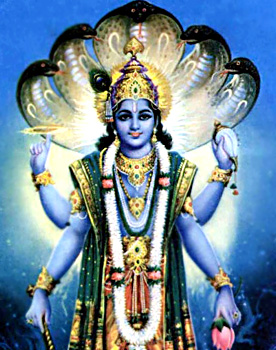 Creation of Universe, according to the Visistadvaita Vedanta, is of two types. These are known as known as samasti sristi or creation of the aggregate universe and vyasti sristi or creation of the universe of space and time with all its diversity. In the first stage, Brahman or Isvara as the creator of the universe causes the evolution of prakriti through various stages as outlined above up to the five gross elements. After this stage is reached, the second kind of creation starts by admixing the five physical elements in certain proportion. This is technically called panchakarana or quintuplication of the five elements. This is done in the following manner. First the aggregate of each of the five elements is divided into equal parts; then each half is subdivided into four parts; in the next stage, taking this one-eighth portion of each of the five elements it is mixed with the half part of each of the bhutas. This means that each element such as akasa comprises half of that element and one-eighth portion of other four elements. The rest of the creation of the physical universe with all its diversity is made out of pancha bhutas or the five elements thus mixed up. The admixture of the elements is supported by the Upanishads. It is also justified by the fact that all objects in the universe including the human body are constituted of all the five elements in varying proportion.
Creation of Universe, according to the Visistadvaita Vedanta, is of two types. These are known as known as samasti sristi or creation of the aggregate universe and vyasti sristi or creation of the universe of space and time with all its diversity. In the first stage, Brahman or Isvara as the creator of the universe causes the evolution of prakriti through various stages as outlined above up to the five gross elements. After this stage is reached, the second kind of creation starts by admixing the five physical elements in certain proportion. This is technically called panchakarana or quintuplication of the five elements. This is done in the following manner. First the aggregate of each of the five elements is divided into equal parts; then each half is subdivided into four parts; in the next stage, taking this one-eighth portion of each of the five elements it is mixed with the half part of each of the bhutas. This means that each element such as akasa comprises half of that element and one-eighth portion of other four elements. The rest of the creation of the physical universe with all its diversity is made out of pancha bhutas or the five elements thus mixed up. The admixture of the elements is supported by the Upanishads. It is also justified by the fact that all objects in the universe including the human body are constituted of all the five elements in varying proportion.
The Indian Puranas present a vivid description of creation (sristi). In this connection they introduce the concept of anda, the cosmic egg in the vast stretch of water out of which the four-faced Brahma originates for carrying out the rest of the actual creation of the universe. Similarly, for carrying out the process of dissolution of the universe in a reverse order, the concept of Rudra as a deity entrusted with the physical task of dissolution is brought in. What is created needs to be well preserved and protected until the stage of dissolution. For this purpose, a third deity, Lord Vishnu is admitted. The Pancharatra treatises which also deal with the cosmology advance the theory of emanation and bring in the three Vyuha manifestations of the Supreme Being - Samkarsana, Pradyumna and Aniruddha- for explaining the three major cosmic functions of creation, sustenance and dissolution.
In order to accommodate the three other deities, Brahma, Vishnu and Rudra, introduced by the Puranas, the Pancharatra system speaks of two stages of creation, i.e., primary and secondary. The three vyuha deities are put in charge of the three cosmic functions at the first stage and the Puranic deities are entrusted with the three cosmic functions at the second stage.
From the philosophical point of view, Brahman is the primary cause of the universe (jagat kararja) as emphasised in the Taittiriya Upanishad and the second aphorism of Vedanta. Brahman, as the metaphysical ground of the universe, is responsible for creation, sustenance and dissolution. Even if other deities actually perform these three functions, it is Brahman as their antaratma or in-dweller controlling them from within that causes the different cosmic functions.
Thus discussed above is the process of the creation of the Universe according to the Vaishnava belief system.












